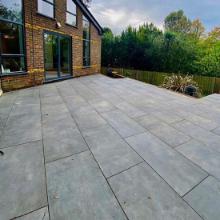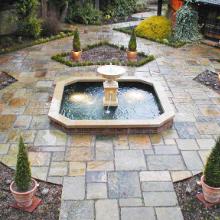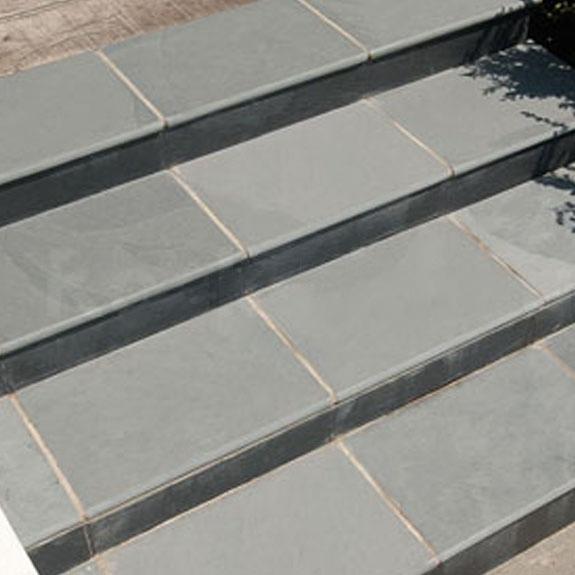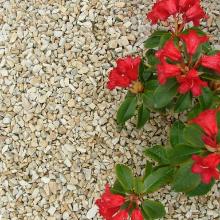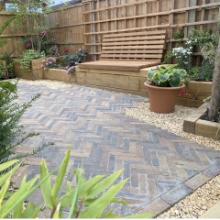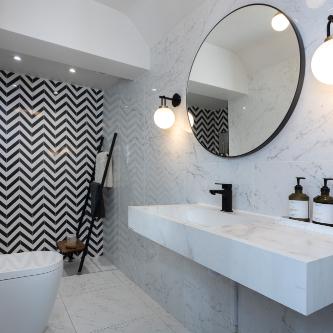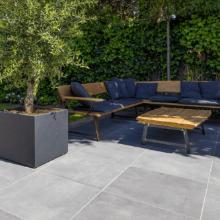When selecting porcelain paving, tile thickness is more than a matter of weight — it directly affects strength, installation method, and long-term durability. Modern porcelain is available in a range of thicknesses, most commonly 9 mm, 16 mm, 20 mm, and occasionally 30 mm, each designed for specific applications. Understanding these differences ensures that the right tile is chosen for the right setting.
Porcelain tiles with a thickness of around 9 mm are primarily designed for indoor applications, such as kitchens, bathrooms, and living areas. At this thickness, the tiles are lightweight, easy to cut, and suitable for use with underfloor heating. They may also be used in covered outdoor areas such as verandas or loggias, provided they are laid on a rigid screed or concrete base with appropriate adhesive. However, 9 mm tiles are not recommended for free-standing outdoor paving, as they may fracture under heavy loads or uneven support.
At 16 mm, porcelain provides additional strength compared to indoor tiles but still requires
continuous support beneath the entire surface. These tiles are not suitable for pedestal systems or dry installations, as point loading or voids beneath the tile can lead to cracking. The best method for installing 16 mm porcelain is full-bed adhesive fixing onto a properly prepared concrete or screed substrate. Adhesives formulated for external use provide strong, uniform contact across the tile’s base, preventing flexing or hollow spots. Because these tiles are thinner than the standard 20 mm slabs, they can be more susceptible to cracking if malleted into a semi-wet mortar bed or laid with uneven support. For this reason, mechanical compaction during laying should be avoided, and care must be taken to achieve full adhesion. This thickness is often chosen for transitional indoor–outdoor areas where the same surface appearance continues through bifold or sliding doors. It balances strength with reduced weight, making it ideal where building structure or height
thresholds limit load or buildup. In some cases, 16 mm tiles are also selected when a manufacturer does not produce matching interior and exterior ranges, allowing designers to achieve visual continuity using the same product across both spaces.
The 20 mm porcelain slab has become the industry standard for external paving. It combines excellent mechanical strength with ease of installation, capable of withstanding vehicle loads on driveways when properly supported. This thickness allows for flexible laying options: it can be bedded in mortar, laid dry on gravel or grass, or installed on adjustable pedestals. Because of its density and vitrified structure, it remains frost-proof, stain-resistant, and non-porous even after years of exposure. Almost all producers now design their exterior collections around this specification.
At 30 mm, porcelain enters the realm of heavy-duty paving for commercial forecourts, public plazas, or areas subject to vehicular traffic. These thicker slabs offer exceptional load-bearing capacity.
Their strength and dimensional accuracy make them ideal where durability and safety are critical, though they are usually unnecessary for typical domestic installations.
Tile thickness determines how a porcelain product performs, how it’s installed, and where it should be used.
9 mm: indoors and covered areas.
16 mm: adhesive-laid transitional or terrace installations requiring full support.
20 mm: standard for outdoor paving and versatile installation options.
30 mm: commercial and vehicular applications.
Choosing the correct thickness ensures lasting strength, stability, and performance — matching the engineering of the tile to the demands of its environment.
